1998 GMC SIERRA height
[x] Cancel search: heightPage 28 of 452
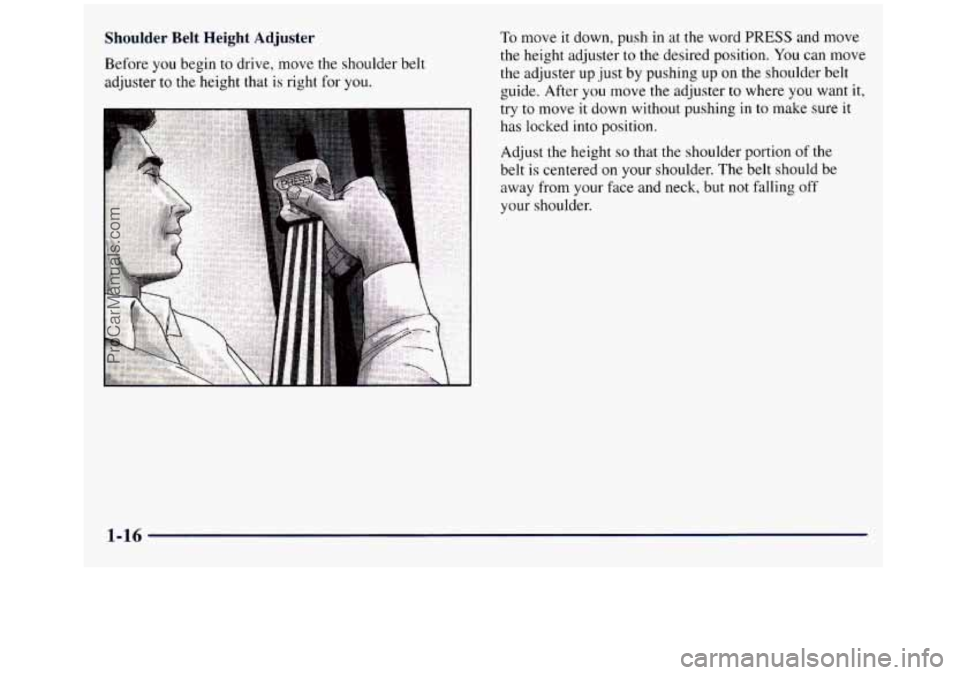
Shoulder Belt Height Adjuster
Before you begin to drive, move the shoulder belt
adjuster to the height that
is right for you.
To move it down, push in at the word PRESS and move
the height adjuster
to the desired position. You can move
the adjuster
up just by pushing up on the shoulder belt
guide. After you move the adjuster to where you want
it,
try to move it down without pushing in to make sure it
has locked into position.
Adjust the height
so that the shoulder portion of the
belt is centered
on your shoulder. The belt should be
away from your face and neck, but
not falling off
your shoulder.
1-16
ProCarManuals.com
Page 43 of 452

Adding Equipment to Your Air
Bag-Equipped Vehicle
e.” If I add a push bumper or a bicycle rack to the
front of my vehicle, will it keep the air
bags
from working properly?
A: As long as the push bumper or bicycle rack is
attached to your vehicle so that the vehicle’s basic
structure isn’t changed, it’s not likely to keep the
air bags from working properly in a crash.
Q.” Is there anything I might add to the front of the
vehicle that could keep the air bags from
working properly?
A: Yes. If you add things that change your vehicle’s
frame, bumper system, front end sheet metal or
height, they may keep the air bag system from
working properly. Also, the air bag system may
not
work properly if you relocate any of the air bag
sensors. If
you have any questions about this, you
should contact Customer Assistance before you
modify your vehicle. (The phone numbers and
addresses for Customer Assistance are
in Step Two
of the Customer Satisfaction Procedure in this
manual. See “Customer Satisfaction Procedure” in
the Index.)
What if I add a snow plow? Will it keep the air
bags from working properly?
A: We’ve designed our air bag systems to work
properly under a
wide range of conditions,
including snow plowing with vehicles equipped
with the
optional Snow Plow Prep Package (RPO
VYU). But don’t change or defeat the snow plow’s
“tripping mechanism.”
If you do, it can damage
your snow plow and your vehicle, and
it may cause
an air bag inflation.
ProCarManuals.com
Page 59 of 452
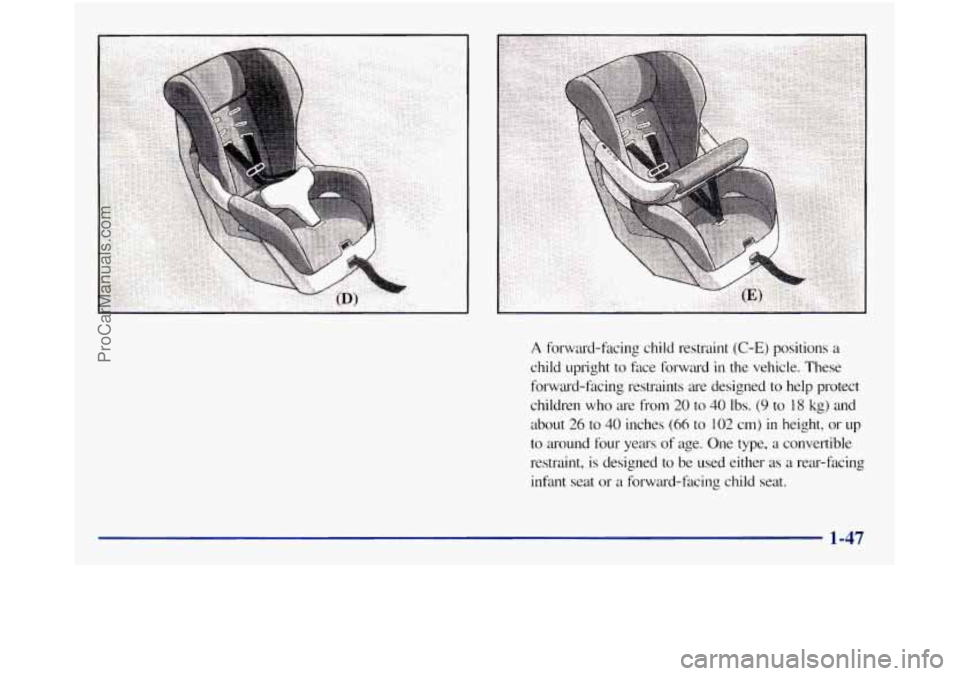
A forward-facing child restraint (C-E) positions a
child upright to fxe folwa-d in the vehicle. These
forward-facing restraints
a-e designed to help protect
children
who are from 20 to 40 Ibs. (9 to 18 kg) and
about
26 to 40 inches (66 to 102 cm) in height, or up
to around four years of age. One type, a convertible
restraint, is designed to be used either
as a rear-facing
infant seat or
a forwa-d-facing child seat.
1-47
ProCarManuals.com
Page 328 of 452
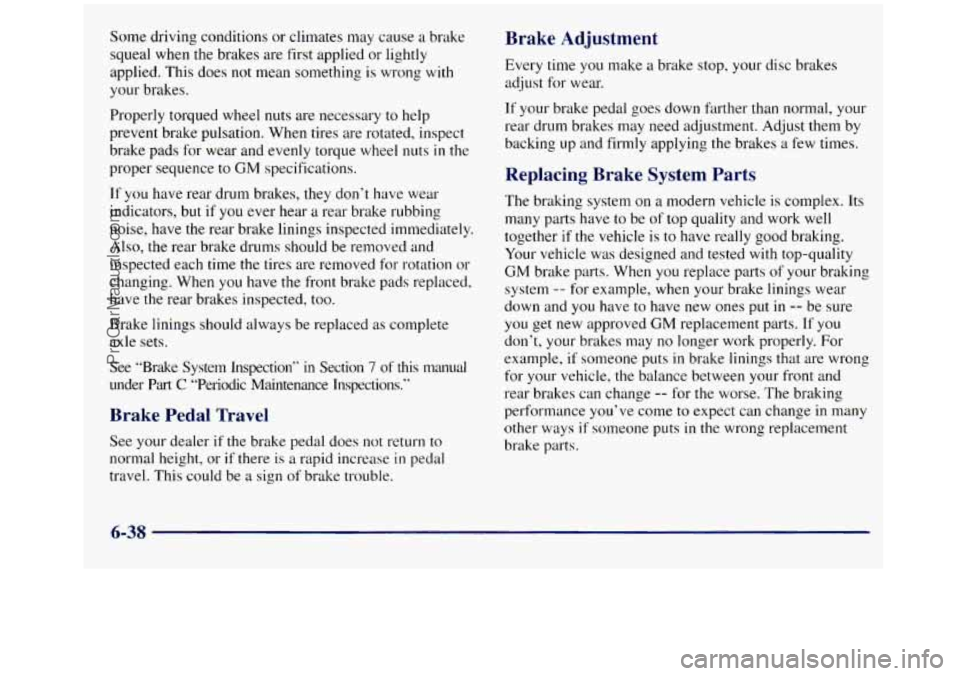
Some driving conditions or climates may cause a brake
squeal when the brakes are first applied or lightly
applied. This does
not mean something is wrong with
your brakes.
Properly torqued wheel
nuts are necessary to help
prevent brake pulsation. When tires are rotated, inspect
brake pads for wear and evenly torque wheel nuts
in the
proper sequence to
GM specifications.
If you have rear drum brakes, they don‘t have wear
indicators, but if you ever hear a rear brake rubbing
noise, have the rear brake linings inspected immediately. Also, the rear brake drums should be removed and
inspected each time the tires are removed for rotation
or
changing. When you have the front brake pads replaced,
have the rear brakes inspected, too.
Brake linings should always be replaced as complete
axle sets.
See “Brake System Inspection”
in Section 7 of this manual
under
Part C “Periodic Maintenance Inspections.”
Brake Pedal Travel
See your dealer if the brake pedal does not return to
normal height, or
if there is a rapid increase in pedal
travel. This could be a sign of brake trouble.
Brake Adjustment
Every time you make a brake stop, your disc brakes
adjust for wear.
If your brake pedal goes down farther than normal, your
rear drum brakes may need adjustment. Adjust them by
backing
up and firmly applying the brakes a few times.
Replacing Brake System Parts
The braking system on a modern vehicle is complex. Its
many parts have to be
of top quality and work well
together if the vehicle is to have really good braking.
Your vehicle was designed and tested
with top-quality
GM brake parts. When you replace parts of your braking
system
-- for example, when your brake linings wear
down and you have
to have new ones put in -- be sure
you get new approved
GM replacement parts. If you
don’t,
your brakes may no longer work properly. For
example,
if someone puts in brake linings that are wrong
for your vehicle, the balance between your front and
rear brakes can change
-- for the worse. The braking
performance you’ve come
to expect can change in many
other ways
if someone puts in the wrong replacement
brake parts.
6-38
ProCarManuals.com
Page 349 of 452
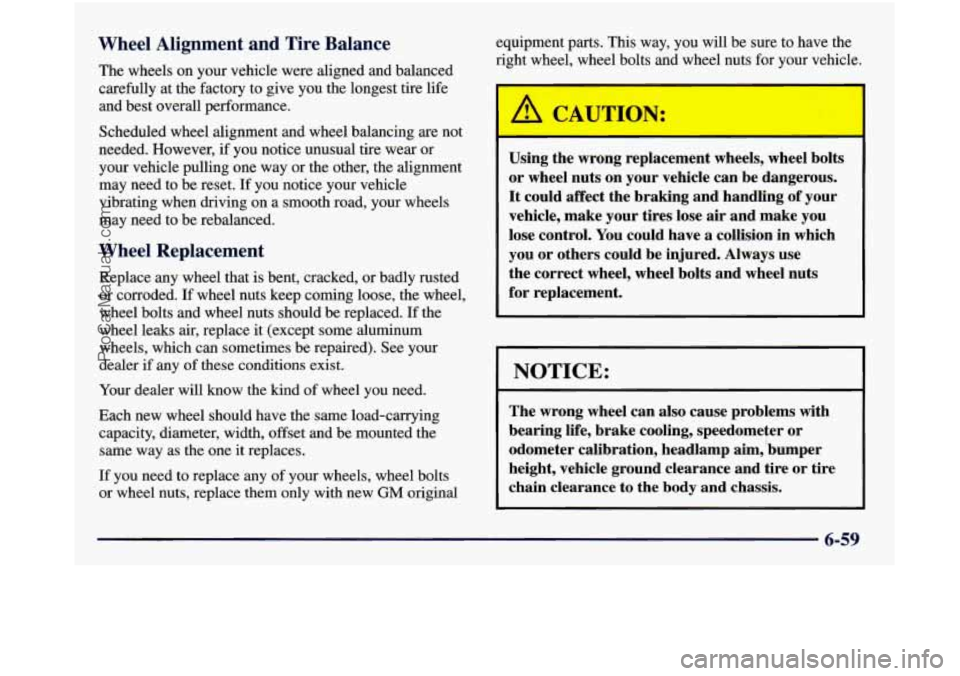
Wheel Alignment and Tire Balance
The wheels on your vehicle were aligned and balanced
carefully at the factory to give you the longest tire life
and best overall performance.
Scheduled wheel alignment and wheel balancing are not
needed. However,
if you notice unusual tire wear or
your vehicle pulling one way or the other, the alignment
may need to be reset.
If you notice your vehicle
vibrating when driving on a smooth road, your wheels
may need to be rebalanced.
Wheel Replacement
Replace any wheel that is bent, cracked, or badly rusted
or corroded. If wheel nuts keep corning loose, the wheel,
wheel bolts and wheel nuts should be replaced. If the
wheel leaks
air, replace it (except some aluminum
wheels, which can sometimes be repaired). See your
dealer if any
of these conditions exist.
Your dealer will know the kind of wheel you need.
Each new wheel should have the same load-carrying
capacity, diameter, width, offset and be mounted the
same way as the one it replaces.
If you need to replace any of your wheels, wheel bolts
or wheel nuts, replace them only with new
GM original equipment
parts. This way, you will be sure to have the
right wheel, wheel bolts and wheel nuts for your vehicle.
~ Using the wrong replacement wheels, wheel bolts
or wheel nuts on your vehicle can be dangerous.
It could affect the braking and handling of your
vehicle, make your tires lose air and make you
lose control. You could have a collision in which
you or others could be injured. Always use
the correct wheel, wheel bolts and wheel nuts
for replacement.
~
NOTICE:
The wrong wheel can also cause problems with
bearing life, brake cooling, speedometer or
odometer calibration, headlamp aim, 'bumper
height, vehicle ground clearance and tire or tire
chain clearance to the body and chassis.
6-59
ProCarManuals.com
Page 443 of 452
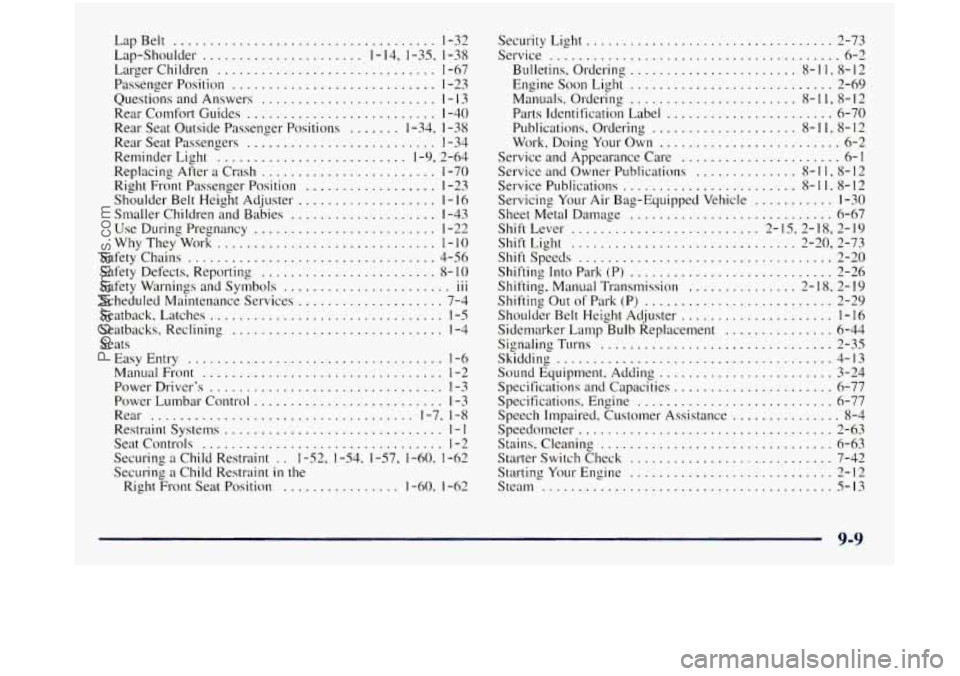
LapBelt .................................... 1-32
Lap-Shoulder
...................... 1.14. 1.35. 1-38
Larger Children
.............................. 1-67
Passenger Position
............................ 1-23
Questions and Answers
........................ 1 . I3
Rear Comfort Guides .......................... 1-40
Rear Seat Outside Passenger Positions ....... 1.34. 1-38
Rear Seat Passengers
.......................... 1-34
Reminder Light .......................... 1.9. 2.64
Replacing After a Crash ........................ 1-70
Right Front Passenger Position
.................. 1-23
Smaller Children and Babies
.................... 1-43
Use During Pregnancy ......................... 1.2 2
Safety Chains
.................................. 4-56
Safety Defects. Reporting
........................ 8- IO
Safety Warnings and Symbols ....................... 111
Scheduled Maintenance Services .................... 7-4
Seatback. Latches
................................ 1-5
Seatbacks. Reclining ............................. 1-4
Seats
Easy Entry
................................... 1-6
Manual Front ................................. 1-2
Power Driver's
................................ 1-3
Power Lumbar Control .......................... 1-3
Rear .................................... 1-7.1-8
Restraint Systems .............................. 1 -I
Seat Controls ................................. 1-2
Securing a Child Restraint . . 1.52. 1.54 . 1.57. 1.60. 1-62
Securing
a Child Restraint in the
Right Front Seat Position ................ 1.60 . 1-62
Shoulder
Belt Height Adjuster
................... I . 16
WhyThey Work .............................. 1-10
...
Security Light .................................. 2-73
Service
........................................ 6-2
Engine Soon Light
............................ 2-69
Manuals
. Order~ng ....................... 8- 1 1. 8- I2
Parts Identification Label ....................... 6-70
Publications. Ordering
.................... 8- I 1.8- 12
Work. Doing Your Own
......................... 6-2
Service and Appearance Care
...................... 6-1
Service and Owner Publications .............. 8- I 1. 8- 12
Service Publications
........................ 8- I I . 8-12
Servicing Your Air Bag-Equipped Vehicle
........... 1-30
Sheet Metal Damage
............................ 6-67
Shift Lever
.......................... 2- 15. 2- 18. 2- I9
Shift Light ............................... 2-20.2-73
Shift Speeds
................................... 2-20
Shifting Into Park
(P) ............................ 2-26
Shifting
. Manual Transmission ............... 2- 18. 2- I9
Shifting Out of Park (P) .......................... 2-29
Shoulder Belt Height Adjuster
..................... 1 -16
Sidemarker Lamp Bulb Replacement ............... 6-44
Signaling TU~M
................................ 2-35
Skidding
...................................... 4-13
Sound Equipment. Adding ........................ 3-24
Specifications and Capacmes 6-77
Specifications
. Engine ........................... 6-77
Speech Impaired. Customer Assistance
............... 8-4
Speedometer ................................... 2-63
Stains. Cleaning
................................ 6-63
Starter Switch Check
............................ 7-42
Starting Your Engine
............................ 2-12
Steam ........................................ 5-13
Bulletins.
Ordering
....................... 8- I 1 . 8-12
.. ......................
9-9
ProCarManuals.com